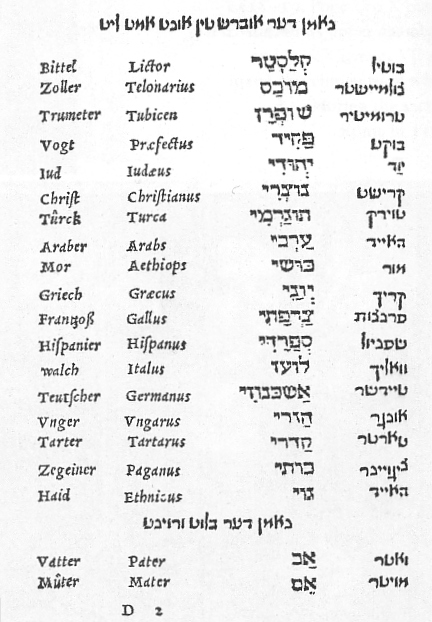  EasternYiddishLanguage EasternYiddishLanguage
|

|
Sigma KEE - EasternYiddishLanguage


|
|
EasternYiddishLanguage
|
|
The EasternYiddishLanguage is a YiddishLanguage of Israel. SIL code: YDD. ISO 639-1: yi. ISO 639-2: yid. Population: 215,000 in Israel, 5% of the population (1986). Population total all countries: 3,000,000 (J.A. Fishman 1991:194). Region: Southeastern dialect in Ukraine and Romania, Mideastern in Poland and Hungary, Northeastern dialect in Lithuania and Belarus. Also spoken in Argentina, Australia, Belarus, Belgium, Canada, Estonia, Hungary, Latvia, Lithuania, Moldova, Panama, Poland, Puerto Rico, Romania, Russia (Europe), South Africa, Ukraine, Uruguay, USA. Alternate names: JUDEO-GERMAN, YIDDISH. Dialects: SOUTHEASTERN YIDDISH, MIDEASTERN YIDDISH, NORTHEASTERN YIDDISH. Comments: Has many loans from Hebrew and local languages where spoken. Eastern Yiddish originated east of the Oder River through Poland, extending into Belarus, Russia (to Smolensk), Lithuania, Latvia, Hungary, Rumania, Ukraine, and pre-state British-Mandate Palestine (Jerusalem and Safed). Western Yiddish originated in Germany, Holland, Switzerland, Alsace (France), Czecholovakia, western Hungary, and is nearing extinction. It branched off medieval High German (mainly Rhenish dialects) and received Modern German influences during the 19th and early 20th centuries. Eastern and Western Yiddish have difficult inherent intelligibility, because of differing histories and influences from other languages. There are some Western Yiddish speakers in Israel too (M. Herzog 1977). The vast majority speak Eastern Yiddish. SVO. Usually written in Hebrew character. Radio programs. Jewish. Bible 1821-1936. Also spoken in: Latvia. (Language name: YIDDISH, EASTERN.) Population: 40,000 (1991). Alternate names: JUDEO-GERMAN. Comments: Of the 1,811,000 Jewish people listed in the 1979 USSR census, the majority spoke Russian as their first language and virtually all others spoke Russian as their second language. About 50,000 Jews spoke Georgian, Tat, or Tajiki as their first language. There may be no Yiddish speakers in Latvia now (1995). Had literary status, but very little literature. Jewish. Bible 1821-1936.(extract from http://www.ethnologue.com/)
|
|
Relationships
|
|
|
|
| Instances | ContentBearingPhysical | Un Object o Process que expresa contenido. Esto cubre los Objects que contienen una Proposition, como un libro, así como un ManualSignLanguage, por lo que puede contener una Proposition. |
| | Entity | La clase universal de individuos. Es el nodo principal de la ontología. |
| | GermanicLanguage | A GermanicLanguage is any of 58 closely related IndoEuropeanLanguages spoken in the UnitedKingdom and northern and central Europe.(extract from http://www.ethnologue.com/) |
| | HumanLanguage | La subclass de Languages usados o sea «lenguajes naturales» por Humans. |
| | IndoEuropeanLanguage | There are 433 languages categorized as an IndoEuropeanLanguage, forming a major family of the world's languages and including many of the most familiar languages of Europe and South Asia.(extract from http://www.ethnologue.com/) |
| | Language | Un sistema de signos para expresar pensamientos. El sistema puede ser natural o artificial, por ejemplo, algo que emerge poco a poco como un artefacto cultural o algo se crea intencionalmente por una persona o grupo de personas. |
| | LanguageFamily | A LanguageFamily is group of SpokenHumanLanguages related through descent from a common ancestral language. (reference from https://en.wikipedia.org/wiki/Language_family) |
| | LinguisticExpression | Esta es la subclase de ContentBearingPhysical que es relacionada con idiomas. Note que esta Class abarca ambos Language y los elementos de Languages, por ejemplo Words «palabras». |
| | NaturalLanguage | La subclass de HumanLanguages (lenguajes naturales) que fueron diseñados y que evolucionaron de generación a generación. Esta clase incluye todos los lenguajes nacionales como el inglés, el español y el japonés, etc. Note que esta clase incluye los dialectos de lenguajes naturales. |
| | Physical | Una entidad que tiene ubicación en espacio-tiempo. Note que las ubicaciones se entienden tener sitio en espacio-tiempo. |
| | WestGermanicLanguage | |
| | YiddishLanguage | Of the 43 WestGermanicLanguages, two are classified as a YiddishLanguage.(extract from http://www.ethnologue.com/) |
|
Belongs to Class
|
IndoEuropeanLanguage |
| | |
 |
Show full definition (without tree view)
Show full definition (with tree view)
|